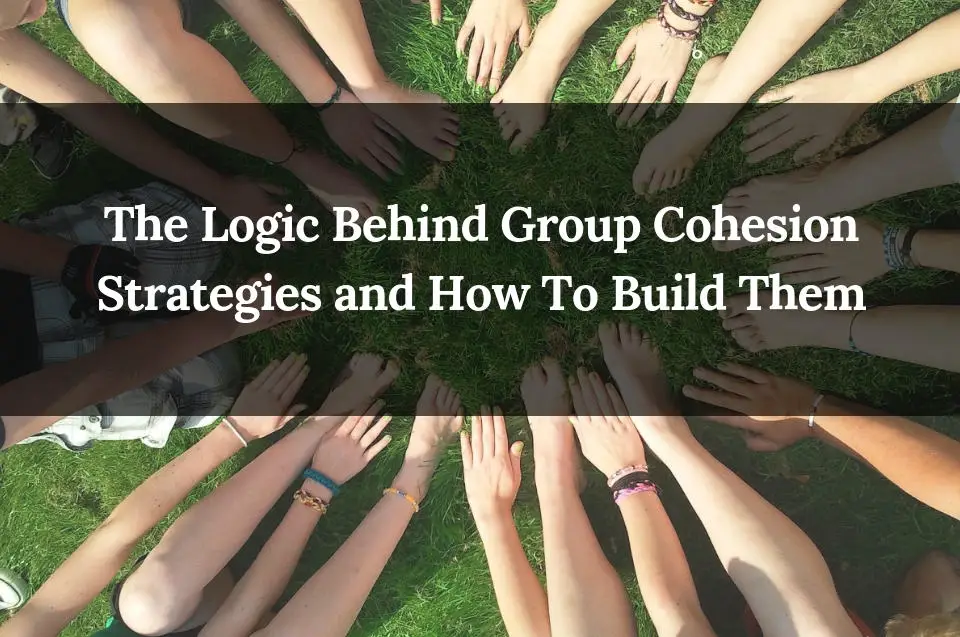Table of Contents
A cohesive team is a successful team. Groups are often composed of a variety of personalities and skill-sets. While it can be challenging to maintain team harmony, doing so is absolutely vital. This is to ensure team longevity and success.
Members will not stick around long in a disharmonious environment. The time they do spend there may not be as productive nor as rewarding as working in a team that is a well-oiled, unified machine.

Fortunately, there are a lot of techniques to maximize team adhesion in the form of group cohesion strategies.
*This post may contain affiliate links. As an Amazon Associate we earn from qualifying purchases.
What Are Group Cohesion Strategies?
Group cohesion strategies are techniques for building strong, cohesive teams. These strategies help to build rapport between team members. In order for the group to be harmonious and effective.
These strategies can be used in any situation involving a group, from sports teams to offices. They can be implemented for small groups or on a large scale for whole organizations.
These methods are useful whether your team is already great and you want to keep it that way. Or, it’s on the rocks and needs to get to a better spot.
What Is the Logic Behind Group Cohesion Strategies?

The logic behind these strategies is quite simple. There are known issues that commonly threaten a group’s unity. Those include stress, unproductive conflicts, and lack of trust, to name a few.
Cohesion strategies are methods for building initial group unification as well as ensuring the team remains solid. These strategies work to prevent the aforementioned factors from creating unhealthy group dynamics.
A cohesive group is not only more effective but also less stressful and more fun.
When Should You Use Group Cohesion Strategies?
Group cohesion strategies are generally useful anytime there is a team or group environment. Here are some specific instances when they are particularly useful.
Forming a new team
When a team is new and the members do not know each other, this is a great time to use some cohesion strategies.
Trust is one of the essential strategies.
And, this is in short supply when a team is new. Cohesion strategies from the onset will jump-start the team for harmony and success from the beginning.
Gearing up for a challenge
Whenever your team is about to hit a challenging time, it’s a good time to break out some cohesion strategies. Team members tend to get anxious during these times. Then, adhesion can fall apart.
With the right mechanisms, however, your team can weather the storm.
New goals

When the team needs to realign itself with new goals, this is an important time to work on group cohesion. Changes in goals can be challenging for a team, even one that was previously cohesive.
Ensuring the team remains united through a change in objectives is of paramount importance. This ensures the team to remain strong and meets the new goals. These tactics can help everyone stay on track to meet the new mission.
New members
Membership changes to teams can upset group solidarity. In this way, strategies can be helpful for integrating new members into the fold. As a result, this keeps the team’s focus on track.
They can also help with trust building between the new members and the existing team.
Low morale
Team morale can decline due to a variety of factors.
For whatever reason, sometimes a toxic team attitude can be a big problem. It’s never too late to implement strategies. In fact, is critical to do so. Often with consistent implementation of new cohesive strategies, the team’s attitude can shift and unity can result.
Anytime!
There’s really no bad time to ensure your team is cohesive. Even if the group is currently operating as a unified machine, building strategies can help solidify a team’s unity.
Implementing cohesion tactics while a group is already on track can ensure it stays on course through unexpected transitions and challenges down the road.
How To Build Group Cohesion Strategies
Now that you know the logic behind these strategies and some great times to use them, let’s get into some specific strategies your team can build into its culture.
Recruitment

Although this is very early on in the team-building process, it’s a very important phase. Making sure the team members will be a good fit from the beginning is vital for group cohesion.
Aim to add members who have a consistent history of being positive, considerate, team players, and adaptable.
Those are the individuals most likely to weather challenging times without spreading a toxic or divisive attitude among the group.
Goals
Another key to a cohesive team is to make sure it focuses on the same goals. Ideally, all the team members will be involved in the goal-forming process. This secures buy-in and better ensures the team will want to work toward the goals together.
Even if the goals themselves will not involve team input, there are ways to better ensure a unified journey towards common goals. Make sure the goals are well known to the whole group.
Go over them regularly and ask for ideas from the team about how to meet objectives. It should be understood by each member how his or her role is related to meeting the common goals.
Trust

Trust is essential to a cohesive team. It’s vital to develop a culture within the team that is nonjudgmental and supportive of members sharing ideas with each other.
While constructive and respectful disagreement over a difference of ideas is healthy, unnecessary ridicule over ideas has no place in a cohesive team.
One of the biggest benefits of trust within a team, which leads to strong cohesion, is open communication.
Members must feel they can communicate openly, so long as the communication is respectful, without fear of negative repercussions.
Some companies use trust-building exercises and games to fast-track the trust-building process. The biggest impact on team trust will come from the following:
- consistent cultivation and maintenance of a culture that is respectful to the members
- kind to new ideas
- amenable to open communication, and
- provides consistent messaging and feedback about goals and expectations.
Empowerment
Empowering the group to make decisions can be an effective cohesion strategy. Ownership is the key to this tactic. This is when members feel they have ownership in the decisions. It’s important to clarify which decisions the team can implement on its own. And which decisions require final approval.
Once a team feels responsible for a decision, a unified plan to achieve the agreed-upon goal is often a natural result.
Emphasis on strengths

A group is often made up of members with a variety of strengths. When the members feel their individual strengths are both acknowledged and utilized, the result is a connection.
And also, when members feel valued for their unique strengths, they are more eager to use those strengths in a productive way.
When everyone brings their strengths to the table and acknowledges each other’s contributions, the team experiences a highly effective form of solidarity.
Conflict management

Tensions lying beneath the surface of a group is one of the worst enemies of group togetherness. It’s certainly better to have a conflict that is openly discussed among the team members. And, this should be emphasized.
However, it should also be emphasized that if team members are unable to resolve a conflict between themselves, they should seek help from a third party. An example is an authority figure to help find a resolution.
Educating team members about how to bring up conflicts and remain respectful to others even when there is disagreement can be helpful to achieve a culture of effective conflict management.
It’s important that persistent conflicts and tensions be brought to the attention of group leaders to prevent the destruction of group cohesion.
Feedback
It’s important that members feel enabled to share feedback about the team, both positive and negative. Through feedback, leaders can identify areas of strengths and weaknesses. Often before any true damage to cohesion has been inflicted.
Whatever the format such feedback takes, it’s critical that messaging consistently conveys the desire for feedback. And, members feel free to give honest feedback without negative results.
Social activities

Another effective strategy is to integrate social events into the team’s schedule. A basketball team need not only play basketball together.
Parties and other get-togethers help the team bond and build trust. This is an important element to team harmony.
Social activities are particularly effective for cohesion when they are centered on a group accomplishment. Allowing the team to relish in its success together is a powerful cohesion tactic that carries momentum onto the next goal.
Final Thoughts
The right group cohesion strategies set a cohesion strategies.
There are many times, such as transitions and busy periods, during which these strategies are particularly vital, but there is never a bad time to work on a team’s cohesion.
Whether your team is just starting off or seasoned, small or large, already solid or falling apart, these strategies are well worth the effort. From trust building to a celebration, it’s time to put these strategies to the test in your group and see how your team thrives.
Featured image: CC0 by vait mcright via Pixabay

